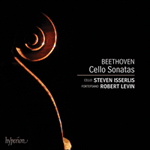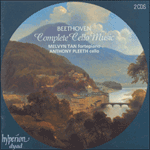
Welcome to Hyperion Records, an independent British classical label devoted to presenting high-quality recordings of music of all styles and from all periods from the twelfth century to the twenty-first.
Hyperion offers both CDs, and downloads in a number of formats. The site is also available in several languages.
Please use the dropdown buttons to set your preferred options, or use the checkbox to accept the defaults.

At the court of King Frederic Wilhelm II he played the two grand sonatas with obbligato violoncello, Op 5, written for [Jean-Pierre] Duport, the King’s first violoncellist, and himself. On his departure he received a gold snuff-box filled with louis d’ors. Beethoven declared with pride that it was not an ordinary snuff-box, but one that it might have been customary to give to an ambassador.
The King, like his uncle Frederick the Great, was a cultivated musician, a cellist for whom Mozart had composed his ‘Prussian’ String Quartets only six years earlier. His influence on the musical life of Berlin was powerful, encouraging the performance of operas by Gluck and Mozart, among other pioneering work, and it seems possible that he offered Beethoven the vacant position of Kapellmeister on the basis of the Cello Sonatas dedicated to him. But the King died the following year, before he could persuade Beethoven, who had anyway since returned to Vienna. Beethoven performed the Sonatas for the first time in Vienna early in 1797 at a concert given with the cellist Bernhard Romberg, a former colleague from the Bonn court orchestra who was passing through the Austrian capital on his way north from Italy. By this time, Beethoven had prepared the sonatas for publication; they were advertised by the firm of Artaria in the Wiener Zeitung in February 1797.
The F major Sonata, Op 5 No 1, has only two movements, though both are quite substantial, the first introduced by an Adagio sostenuto that is almost a movement in its own right. It gradually unfolds from arpeggios on the common chord of F major, an idea that is also present in the first subject of the main Allegro, a dolce melody on the piano that is soon repeated on the cello. An extensive bridge passage, dominated by off-beat accents, leads to the fragmentary second subject group in the dominant: semiquaver scales run into a staccato passage on the piano alone before the cello enters with a more melodic idea and the codetta makes way for the wide-ranging development section. The recapitulation is a straightforward restatement of the opening section, but the coda is extended by the interpolation of a short Adagio passage (unrelated to the introduction) and a similarly brief Presto section of dominant preparation to the concluding affirmation of F major. The second and final movement is a rondo in 6/8 time with a main theme that makes much play out of a rhythmic displacement between the two instruments.
from notes by Matthew Rye © 1996
extrait des notes rédigées par Matthew Rye © 1996
Français: Hypérion
aus dem Begleittext von Matthew Rye © 1996
Deutsch: Ute Mansfeldt
 Beethoven: Cello Sonatas Beethoven: Cello SonatasIn this chamber recording, Steven Isserlis—together with his regular collaborator, fortepianist Robert Levin—presents a magisterial and long-awaited compendium of Beethoven’s complete works for cello and piano.» More |
 Beethoven: Complete Cello Music Beethoven: Complete Cello Music‘A distinguished contribution not only to the burgeoning corpus of period recordings, but to a continuing tradition of cello playing’ (Gramophone) ‘An attractive issue for anyone wanting period versions’ (The Penguin Guide to Compact Discs)» More |

